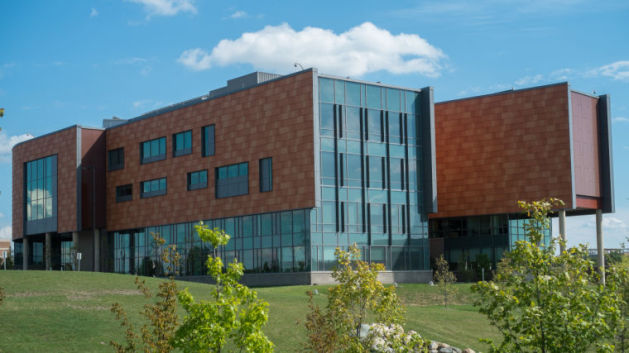Black, gold and green: Human Health Building attains platinum status
The U.S. Green Building Council awarded Oakland University’s Human Health Building with a LEED Platinum certification.
The LEED system, which stands for Leadership in Energy and Environmental Design, is a third-party rating system developed by the USGBC.
How it’s judged
LEED takes into account building sustainability, water efficiency, energy and atmosphere, materials and resources and indoor environment quality when certifying buildings with their silver, gold and platinum labels.
“It appears to be the first higher education building in the State of Michigan to achieve LEED Platinum,” said John Harmala, senior project manager, Capital Planning and Design.
SmithGroupJJR, one of the oldest architecture and engineering firms in Michigan, verified this fact.
Harmala was responsible for managing the scope, schedule and budget of the project.
The ability to achieve LEED Platinum was facilitated by a $2.7 million Department of Energy grant, according to Harmala.
“I believe that the Human Health Building demonstrates that Oakland University is serious about sustainability and the educational experience on campus,” Harmala said.
Going green
Terry Stollsteimer, OU associate vice president of Facilities Management, said this building is about encouraging and educating the OU community on sustainability and being green.
“The hope is that the students, staff and faculty begin to use these ideas and practices in their everyday life,” Stollsteimer said.
“Green thinking” was implemented in every aspect of this project, from the design stages through completion.
The construction team tried to use building materials that were made regionally, which cut down on pollution from shipping and supported regional businesses.
The HHB was built for best sun position, running east to west, to conserve energy.
There is a long patio that runs along the building and overlooks the reconstructed wetland where wildlife can be seen.
Outside of the HHB, there are charging stations for electric vehicles.
The HHB utilizes a geothermal heat pump system that uses the earth as a source for the pumps to provide heating and cooling for the building efficiently.
The pumps capture heat in the summertime that is used to warm the building during the winter and for cooling in the summer.
The HHB is the first academic building nationwide to have the largest variable refrigerant flow system in the U.S., which allows simultaneous heating and cooling.
Future-minded
As a result of the project, Stollsteimer said the Board of Trustees now requires his staff to try to obtain at least LEED Gold for all significant OU buildings.













